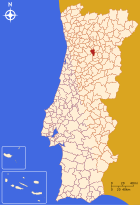Vila Nova de Paiva
| Vila Nova de Paiva | ||||||
|---|---|---|---|---|---|---|
|
||||||
| Basic data | ||||||
| Region : | Centro | |||||
| Sub-region : | Dão-Lafoes | |||||
| District : | Viseu | |||||
| Concelho : | Vila Nova de Paiva | |||||
| Coordinates : | 40 ° 51 ′ N , 7 ° 44 ′ W | |||||
| Residents: | 1288 (as of June 30, 2011) | |||||
| Surface: | 8.43 km² (as of January 1, 2010) | |||||
| Population density : | 153 inhabitants per km² | |||||
| politics | ||||||
| Mayor : | Horácio Manuel Sousa Leal ( PSD ) | |||||
| Vila Nova de Paiva county | ||||||
|
||||||
| Residents: | 5176 (as of June 30, 2011) | |||||
| Surface: | 175.54 km² (as of January 1, 2010) | |||||
| Population density : | 29 inhabitants per km² | |||||
| Number of municipalities : | 5 | |||||
| administration | ||||||
| Administration address: | Câmara Municipal de Vila Nova de Paiva Praça D. Afonso Henriques 1 3650-194 Vila Nova de Paiva |
|||||
| President of the Câmara Municipal: | Dr. José Morgado Ribeiro ( PS ) | |||||
| Website: | www.cm-vnpaiva.pt | |||||
Vila Nova de Paiva is a small town ( Vila ) and a district ( concelho ) in Portugal with 5176 inhabitants on an area of 175.5 km² ( as of June 30, 2011 )
history

Dolmen of Anta de Pendilhe
|
The Anta de Pendilhe and other megalithic sites are evidence of prehistoric settlement. Later rock graves show the existence of the current village since the 7th century AD. At least since the 11th century AD there was an independent community here. The place was called Vila de Barrelas and belonged to the Fráguas district until it became the seat of the district in 1883 . In the course of this, both the district and the place received their current name, with reference to the location on the Paiva , a river that flows into the Douro at Castelo de Paiva .
administration
circle
Vila Nova de Paiva is the administrative seat of a district of the same name ( concelho ). The neighboring areas are (starting clockwise in the north): Tarouca , Moimenta da Beira , Sátão , Viseu and Castro Daire .
With the territorial reform in September 2013 , the municipalities ( Freguesias ) Vila Nova de Paiva, Alhais and Fráguas were combined to form the new municipality União das Freguesias de Vila Nova de Paiva, Alhais e Fráguas . Since then, the district has consisted of the following five municipalities:
The following municipalities ( Freguesias ) are in the Vila Nova de Paiva district:
| local community | Population (2011) |
Area km² |
Density of population / km² |
LAU code |
|---|---|---|---|---|
| Pendilhe | 546 | 24.19 | 23 | 182203 |
| Queiriga | 575 | 31.94 | 18th | 182204 |
| Touro | 918 | 50.17 | 18th | 182205 |
| Vila Cova à Coelheira | 1.109 | 32.03 | 35 | 182206 |
| Vila Nova de Paiva, Alhais e Fráguas | 2,028 | 37.21 | 55 | 182208 |
| Vila Nova de Paiva county | 5,176 | 175.54 | 29 | 1822 |
Population development
| 1801 | 1849 | 1900 | 1930 | 1960 | 1981 | 1991 | 2001 | 2004 | 2005 |
|---|---|---|---|---|---|---|---|---|---|
| 709 | 4,686 | 6,954 | 7,400 | 8,931 | 6,420 | 6,088 | 6,090 | 6.318 | 6,479 |
Municipal holiday
- 2nd March
Town twinning
traffic
The place is on the national road N329, which merges into the N229 south at Sátão . The district capital Viseu and its connections to the A25 motorway (here also European route 80 ) and the A24 can be reached about 30 km south. The smaller N323 also leads there in roughly the same length.
Vila Nova de Paiva is part of the Rede Expressos national bus network.
sons and daughters of the town
- Aarão Ferreira de Lacerda (1863–1921), zoologist, doctor and university professor
- José Augusto Correia de Campos (19th century), military man, author and historian
- Cláudio Ramos (* 1991), soccer goalkeeper
The writer Aquilino Ribeiro , who has many connections to Germany , was baptized here, in the municipality of Alhais .
Web links
- Map of the Freguesia Vila Nova de Paiva at the Instituto Geográfico do Exército
- Official website
Individual evidence
- ↑ www.ine.pt - indicator resident population by place of residence and sex; Decennial in the database of the Instituto Nacional de Estatística
- ↑ a b Overview of code assignments from Freguesias on epp.eurostat.ec.europa.eu
- ↑ a b www.ine.pt - indicator resident population by place of residence and sex; Decennial in the database of the Instituto Nacional de Estatística
- ↑ www.monumentos.pt (under Cronologia ), accessed on September 20, 2013
- ↑ ditto
- ↑ ditto
- ^ Publication of the administrative reorganization in the Diário da República gazette of January 28, 2013, accessed on March 16, 2014
- ↑ www.anmp.pt , accessed on September 20, 2013





